RandomTask
Full Member
- Joined
- Feb 18, 2023
- Messages
- 104
I got a question for the members so what kind of floating screen would you suggest on building or buying? I need to come up with something it would be game changing for me on my next hunt.
Heavy zip ties are the way to go!! They hold up well!!Thanks for the info. I like it seems pretty simple to make going to try and build something this weekend post a picture when its all done.

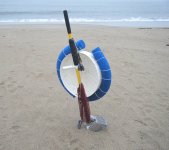
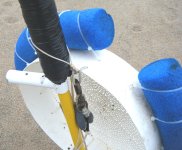
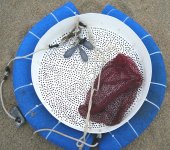
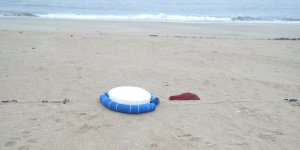
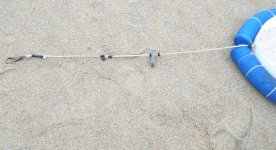
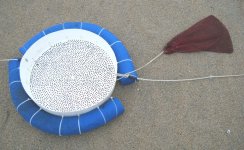
Like the looks of the "classifier".Made a couple of these, cheap and bombproof, main one sees lots n lots of use over years, have yet to need the spare inserted into use. Keene 1/4" classifier (ordered from a mining company in Colorado) and a large pool noodle with some long zip ties.
 I had no knowledge of such a thing.
I had no knowledge of such a thing.
I am going to make it. Thanks for all of your info post pics when i am done.Heavy zip ties are the way to go!! They hold up well!!
The white tub is the bottom part of a 50 gallon barrel with lotsa holes just small enough that a .22 cal bullet can't fall through.
Allow about 1/2" of space from the holes to the curve at the side for maximum strength.
Another post from he past-------------------
Mar 3, 2012
A Hunter Friend from Australia asked for more details of my sifter and this AM I thought I would oblige with a short photo essay illustrating every point I considered when I built mine.
My desire was for a highly functional sifter that cost as little as possible and I built several over the years using metal screens, inner-tubes, etc.
They all worked, but I couldn't use my coil to determine if I had the target in the pile of stone etc. dumped from my scoop and as I got older, with eyes to match, I wasn't able to use a pin-pointer to find the tiny targets.
While on a dump run one day I saw several tubs some commercial fisherman had tossed into the bin there for such things. They were sturdy and could be easily cut to the size I needed and were free!
The one I chose is 20" in diameter, (I cut it to) 5" deep and handles the scoop load nicely. I wouldn't recommend one much smaller unless you are hunting only in sand. I prefer the white bottom for visibility and that it be flat to allow for easy sorting through the debris.
A sifter larger than 24" will tend to be too large in must hunting situations,
Using the idea of drilling hundreds of small holes, borrowed from KaptKosmic, I proceeded to build the sifter illustrated here.
My experience had been that inner tubes as floats were a pain in that they required replacing from time to time and were usually flat when I needed them.
Solution=Floaties which I also found at the dump and later at Walmart for less than $5.00. The larger the diameter the better. On my sifter I used only one which lasted a couple of seasons and then started to shred apart.
The blue floats I am currently using were salvaged from a floating pool chair I came across at the dump. They are the perfect size to keep the sifter floating high in the water.
In the pics you will notice I placed the holes for mounting the Floaty low on the sides to keep the bottom high in the water. This works out well when in the shallows and makes locating targets easier too. I started out lacing a cord through the holes to secure the Floaties, but graduated to all plastic, electrical quick ties as a fast, inexpensive method.
The bottom curves as it reaches the wall of the sifter and allows dragging a target up the side when wearing gloves so that I can pinch it between my fingers without struggling to grasp it as it lays flat on the bottom. (Harder to do in rough water where sometimes I am able to cause the small target to lift off the bottom by a short brisk push down on the sifter bottom. The water jetting upward through the holes will often lift the target enough to grab it.)
The tow line is anchored into the side via two holes through the side for a strong attachment that has worked well for several years now.
There is a loop in the draw-string to the nylon mesh trash-bag where it is tied on for me to slip over the scoop handle for easy transporting on my shoulder to and from the water.
The draw-string is left over a foot long to provide distance from the sifter as the larger finds contained there-in, all smaller finds are secured in my waist pouch, will interfere with using the coil to locate finds if it is too close.
The tow-line has a brass snap hook (Notice in pics 2 and 3 how this hook is used to secure the weights etc for travel.) I dug up one day that attaches to a stainless loop of heavy wire on my belt at the center of my back. This keeps the tow-line out of my way most of the time.
This line used to be shorter, but then the sifter was in my way too often so I made it longer and placed a 1Lb.weight on it to keep tension on it when I step toward the sifter.
The sifter is now out of the way most of the time and I don't find myself chasing it with my scoop-load in windy conditions or when the current is strong enough to push the sifter away as I step toward it.
Tension on the drag-line with the 3 Lbs. of weight at the end keeps the whole rig under control most of the time and allows me to concentrate on the target and not have to be battling the sifter as water conditions change.
I think I have covered all pertinent details here, but let me know if there may be any I missed.
GL&HH,
CJ
Attachments
3-3-12 Sifter Details 002.JPG
104.1 KB · Views: 1,115
3-3-12 Sifter Details 003.JPG
133.4 KB · Views: 1,094
3-3-12 Sifter Details 004.JPG
155.5 KB · Views: 1,082
3-3-12 Sifter Details 007.JPG
79.9 KB · Views: 1,080
3-3-12 Sifter Details 009.JPG
106.9 KB · Views: 1,077
3-3-12 Sifter Details 010.JPG
122.9 KB · Views: 1,0
My posts about the larger sifter have emphasized the load without mentioning the need for stability that is needed in choppy water. I made the sifter in my posts in 2010 as I recall and have dumped what must be truck-loads of sand/gravel/stones and targets in it since then!!Well, it works for me, easily and frequently handles load after loadfull of stealth 720 scoops, heaping heavy clay and full loads of rocks. Might have seen the seives at a nwdetectors site. Manufacturer: Keene Engineering (can see on their site under products, seives, economy stackable types)


Fantastic !!!My posts about the larger sifter have emphasized the load without mentioning the need for stability that is needed in choppy water. I made the sifter in my posts in 2010 as I recall and have dumped what must be truck-loads of sand/gravel/stones and targets in it since then!!
It is waiting in my shed for our next hunt!!!
GL&HH,
CJ

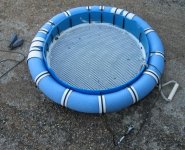
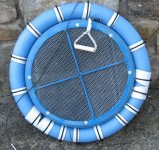
Frank Ya done a great job my Friend!I scrolled through past posts and found my Friend Frank's post of an excellent job of sifter making!!!
Amazing craftsmanship Frank!!!!!!!!!!!
Feb 20, 2012
I finished my sifter that was copied off the one CJ uses. It measures 23" diameter with 7/32" holes. If you notice it has a spot coped out on top to hold my scoop or detector and works excellent.
When I ordered the plate from McMaster Carr it didn't end up being what I thought ( my fault ), I wanted 3/16" holes but I thought the "open area" was more than it was. Also I wasn't crazy about it being grey instead white ( notice the back ) , again my fault.
Shipping was so high and the plate cost $64.00 that I wasn't about to send it back. So, I bit the bullet and drilled out all the holes from 3/16" to 7/32" , sanded the top with very coarse sand paper and sprayed it white.
This was put to the test the other day and worked great. Dumping rocks of all sizes along with the sand handled the heavy load with no problem and sifted rapidly. The holes are small enough that I easily caught 22 caliber projectiles.
Everything is nylon or plastic except for the stainless steel nut I'm using for a toggle for my lead sinkers and that's going to be changed to a nylon nut as soon as I get to the hardware store.
Even with that nut. I still was able to run my coil over the sifter with no problem.



Late to the party Lew... I'm using Franks sifter, don't go in the water without it...Frank Ya done a great job my Friend!
If Ya ever want to trade it in on a new model, let me know!!
You made a couple of creative changes that are improvements in my view, such as the place to rest you scoop, using chafing shields to protect the foam floaty and a carrying handle.
It's as close to perfection as a sifter can get.
Regards,
CJ
Late to the party??? I started the party!!!!!!!!!Late to the party Lew... I'm using Franks sifter, don't go in the water without it...

Late to the party Lew... I'm using Franks sifter, don't go in the water without it...
You aint that oldLate to the party??? I started the party!!!!!!!!!

Just how old does one have to be Craig?You aint that old


